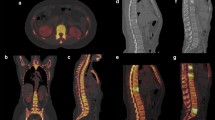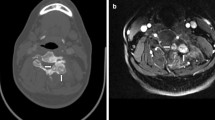Abstract.
Bone scanning is a well-accepted and frequently performed diagnostic procedure with a high sensitivity, especially when single-photon emission tomography (SPET) acquisitions are added. However, the differentiation of benign from malignant osseous lesions often poses difficulty. The purpose of this study was to find out whether the particular localisation of an intraosseous lesion in a lumbar vertebra is an indicator of its aetiology. Bone scintigraphy including planar whole-body scans as well as SPET imaging of the lumbar spine was performed in 109 patients. The diagnoses of osseous lesions in the lumbar vertebrae were made strictly on the basis of the findings of magnetic resonance imaging, computed tomography or plain radiography. Sixteen patients had to be excluded from the study because they did not undergo adequate radiological examination. To determine the particular localisation of vertebral lesions in the bone scan, two experienced nuclear medicine physicians examined the studies independently while blinded to the radiological results. Four anatomical regions were differentiated within the vertebra: the vertebral body, the pedicle, the facet joints and the spinous process. Clopper-Pearson analysis, which takes into account the number of examinations, yielded the following probability intervals for the malignancy of intraosseous lesions in the lumbar spine: vertebral body 36.8%–57.3%, pedicle 87.7%– 100%, facet joints 0.8%–21.4% and spinous process 18.7%–81.3%. It was concluded that lesions affecting the pedicle are a strong indicator for malignancy, whereas involvement of the facet joints is usually related to benign disease. Lesions affecting the vertebral body or the spinous process do not show a clear tendency towards either malignancy or benignity. In contrast to other studies, a significant probability of malignancy (35.6%) was observed in lesions affecting exclusively the vertebral body.
Similar content being viewed by others
Author information
Authors and Affiliations
Additional information
Received 23 November 1999 and in revised form 12 February 2000
Rights and permissions
About this article
Cite this article
Reinartz, P., Schaffeldt, J., Sabri, O. et al. Benign versus malignant osseous lesions in the lumbar vertebrae: differentiation by means of bone SPET. Eur J Nucl Med 27, 721–726 (2000). https://doi.org/10.1007/s002590050568
Issue Date:
DOI: https://doi.org/10.1007/s002590050568




